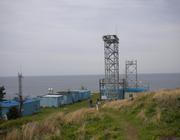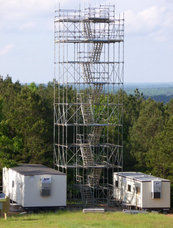Oppenheimer, C, Kyle P, Eisele F, Crawford J, Huey G, Tanner D, Kim S, Mauldin L, Blake D, Beyersdorf A et al..
2010.
Atmospheric chemistry of an Antarctic volcanic plume. Journal of Geophysical Research-Atmospheres. 115
AbstractWe report measurements of the atmospheric plume emitted by Erebus volcano, Antarctica, renowned for its persistent lava lake. The observations were made in December 2005 both at source, with an infrared spectrometer sited on the crater rim, and up to 56 km downwind, using a Twin Otter aircraft; with the two different measurement platforms, plume ages were sampled ranging from <1 min to as long as 9 h. Three species (CO, carbonyl sulfide (OCS), and SO(2)) were measured from both air and ground. While CO and OCS were conserved in the plume, consistent with their long atmospheric lifetimes, the downwind measurements indicate a SO(2)/CO ratio about 20% of that observed at the crater rim, suggesting rapid chemical conversion of SO(2). The aircraft measurements also identify volcanogenic H(2)SO(4), HNO(3) and, recognized for the first time in a volcanic plume, HO(2)NO(2). We did not find NO(x) in the downwind plume despite previous detection of NO(2) above the crater. This suggests that near-source NO(x) was quickly oxidized to HNO(3) and HO(2)NO(2), and probably NO(3(aq))(2-), possibly in tandem with the conversion of SO(2) to sulfate. These fast processes may have been facilitated by "cloud processing" in the dense plume immediately downwind from the crater. A further striking observation was O(3) depletion of up to similar to 35% in parts of the downwind plume. This is likely to be due to the presence of reactive halogens (BrO and ClO) formed through heterogeneous processes in the young plume. Our analysis adds to the growing evidence for the tropospheric reactivity of volcanic plumes and shows that Erebus volcano has a significant impact on Antarctic atmospheric chemistry, at least locally in the Southern Ross Sea area.
Slusher, DL, Neff WD, Kim S, Huey LG, Wang Y, Zeng T, Tanner DJ, Blake DR, Beyersdorf A, Lefer BL et al..
2010.
Atmospheric chemistry results from the ANTCI 2005 Antarctic plateau airborne study. Journal of Geophysical Research-Atmospheres. 115
AbstractOne of the major goals of the 2005 Antarctic Tropospheric Chemistry Investigation (ANTCI) was to bridge the information gap between current knowledge of South Pole (SP) chemistry and that of the plateau. The former has been extensively studied, but its geographical position on the edge of the plateau makes extrapolating these findings across the plateau problematic. The airborne observations reported here demonstrate that, as at SP, elevated levels of nitric oxide (NO) are a common summertime feature of the plateau. As in earlier studies, planetary boundary layer (PBL) variations were a contributing factor leading to NO fluctuations. Thus, extensive use was made of in situ measurements and models to characterize PBL depths along each flight path and over broader areas of the plateau. Consistent with earlier SP studies that revealed photolysis of nitrate in surface snow as the source of NO(x), large vertical gradients in NO were observed over most plateau areas sampled. Similar gradients were also found for the nitrogen species HNO(3) and HO(2)NO(2) and for O(3). Thus, a common meteorological-chemical feature found was shallow PBLs associated with nitrogen species concentrations that exceeded free tropospheric levels. Collectively, these new results greatly extend the geographical sampling footprint defined by earlier SP studies. In particular, they suggest that previous assessments of the plateau as simply a chemical depository need updating. Although the evidence supporting this position comes in many forms, the fact that net photochemical production of ozone occurs during summer months over extensive areas of the plateau is pivotal.
Kim, S, Karl T, Guenther A, Tyndall G, Orlando J, Harley P, Rasmussen R, Apel E.
2010.
Emissions and ambient distributions of Biogenic Volatile Organic Compounds (BVOC) in a ponderosa pine ecosystem: interpretation of PTR-MS mass spectra. Atmospheric Chemistry and Physics. 10(4):1759-1771.
AbstractTwo proton-transfer-reaction mass spectrometry systems were deployed at the Bio-hydro-atmosphere interactions of Energy, Aerosols, Carbon, H(2)O, Organics and Nitrogen-Southern Rocky Mountain 2008 field campaign (BEACHON-SRM08; July to September, 2008) at the Manitou Forest Observatory in a ponderosa pine woodland near Woodland Park, Colorado USA. The two PTR-MS systems simultaneously measured BVOC emissions and ambient distributions of their oxidation products. Here, we present mass spectral analysis in a wide range of masses (m/z 40(+) to 210(+))to assess our understanding of BVOC emissions and their photochemical processing inside of the forest canopy. The biogenic terpenoids, 2-methyl-3-butene-2-ol (MBO, 50.2%) and several monoterpenes (MT, 33.5%) were identified as the dominant BVOC emissions from a transmission corrected mass spectrum (PTR-MS), averaged over the daytime (11 a.m. to 3 p.m., local time) of three days. To assess contributions of oxidation products of local BVOC, we calculate an oxidation product spectrum with the OH- and ozone-initiated oxidation product distribution mass spectra of two major BVOC emissions at the ecosystem (MBO and beta-pinene) that were observed from laboratory oxidation experiments. The majority (similar to 76%) of the total signal in the transmission corrected PTR-MS spectra could be explained by identified compounds. The remainder are attributed to oxidation products of BVOC emitted from nearby ecosystems and transported to the site, and oxidation products of unidentified BVOC emitted from the ponderosa pine ecosystem.





 ]
]